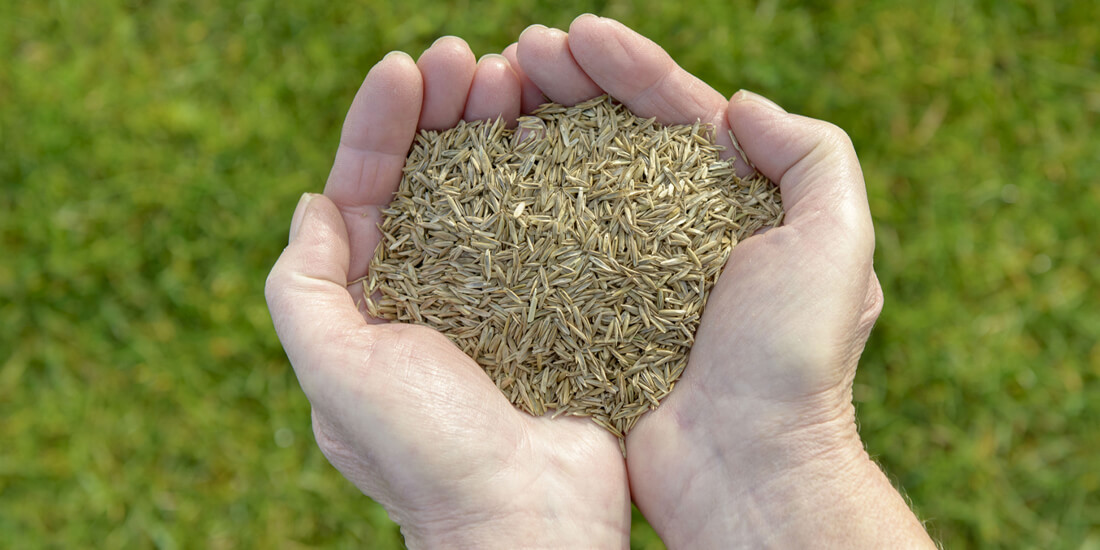2023 UK Grass Seed Guide

Want to learn more about what goes into our mixtures, and what makes them so different? Find out in our 2023 UK grass seed guide
With every single bag of grass seed we dispatch, an accompanying green certificate of paper is attached to the bag. This green slip is a very important document from the Department of Environment, Food and Rural Affairs (DEFRA). It is a certificate to let users know the content of the bag has been tested and conforms to all European standards of germination and quality.
This ministry label will give the exact percentage of each variety within the grass seed mixture. Each variety offers an exotic name, such as Lolium Perenne or Festuca Rubra Rubra, but what do these names mean? Keep reading our 2023 UK grass seed guide for more information...
They are, in actual fact, the botanical name for the grass variety written in Latin. So, we bet you are wondering why we write in Latin on our seed bags; well, it’s not really our decision – it’s the law. All the same, we think it adds to the wonder of a bag full of living things.
Let’s take a closer look at our most commonly used grass varieties:
Guide to UK Grass Seed Varieties in 2023
Perennial Ryegrass (Lolium Perenne)
Perennial ryegrass is a hardwearing grass type which will establish and grow quickly. The seed is undeterred by harsh weather conditions both during germination and once the grass has been fully established, which is definitely of benefit in our changeable climate!
Key Facts
- Seeds per gram: 500-1000
- Recommended Mowing Height 20 - 40mm
- Present in SUPERSTAR: Back lawn and STEADFAST: Shade.
Strong Creeping Red Fescue (Festuca Rubra Rubra)
Strong creeping red fescue is a highly tolerant grass seed species that can thrive under any number of conditions. Most notably it establishes quickly and is tolerant to disease, it will do well in dry and poor soil - ideal for any garden.
Key Facts
- Seeds per gram: 1000
- Minimum mowing height: 6mm
- Present in SUPERSTAR: Back Lawn, RESTORE: Self Repairing Lawn and STEADFAST: Shade mixture.
Chewings Fescue (Festuca Rubra Commutata)
Chewings fescue is a slow-growing grass seed that has fine leaves and a high density. This enables the variety to produce a dense but fine sward, ideal for giving your lawn a much fuller look. This seed will germinate at lower temperatures in comparison to other varieties within the fescue family.
Key Facts
- Seeds per gram: 1000
- Minimum mowing height: 5mm
- Varieties the seed is present in: SUPERSTAR: Back Lawn and STATEMENT: Front Lawn mixture
Slender Creeping Red Fescue (Festuca Rubra Litoralis)
Slender Creeping Red Fescue is similar to Chewings Fescue as it produces a very fine leafed grass sword. A unique feature of slender fescues is that they grow in stolons, which ultimately means they creep and spread through the garden. This allows the lawn to heal and mend itself when damaged, which is ideal for even the less attentive gardener. It is also very tolerant of close and frequent mowing.
Key Facts
- Seeds per gram: 1000
- Minimum mowing height: 5mm
- Varieties the seed is present in: STATEMENT: Front Lawn, RESTORE: Self Repairing Lawn
Smooth Stalked Meadow Grass (Poa Pratensis)
Smooth stalked meadow grass is a shade-tolerant and extremely hardwearing grass seed which is resistant to cold stress. At first, it is slow to develop, only forming small tufts initially. In the following years, it will expand to have maximum ground cover, but users should know this seed variety requires some patience. When established, the leaves will have a subtle blue tint which has led to it also being called Kentucky Blue Grass, don’t worry it’s very subtle.
Key Facts
- Seeds per gram: 4000
- Minimum mowing height: 10mm
- Present in STEADFAST: Shade mixture and STEADFAST: Ultra Shade mixture
Hard Fescue (Festuca Longifolia)
Hard fescue is a fine-leaf grass seed that is known to be the most durable of the fescue family. It is perfect for inclusion in seed mixtures, in which the grass will be subject to low sunlight, low nutrients and possible droughts.
Key Facts
- Seeds per gram: 1000
- Minimum mowing height: 5mm
- Present in STEADFAST: Shade and STEADFAST: Ultra Shade